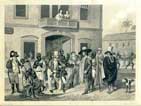| UCLA Library Special Collections |
 |
|
THE
AMERICAS
Before 1840, when travel
across the Atlantic was still by sailing ships, few women
came to the Americas for pleasure. Some, like Maria Graham
and Frances Calderon de la Barca, followed husbands who
were sea captains or diplomats. Others took it upon themselves
to come as social observers and critics. Harriet Martineau,
for example, visited the United States in 1834 specifically
to conduct a two-year sociological study of “the actual
workings of republican institutions.”
|

 |
| 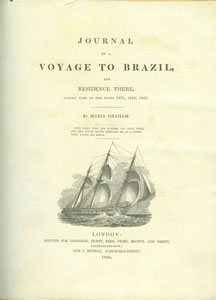
Maria
Graham. Journal of a Voyage to Brazil and Residence
there during the years 1821, 1822, 1823. London: Hurst,
Rees, Orme et. al., 1824. |
Maria
Graham (1785-1842)
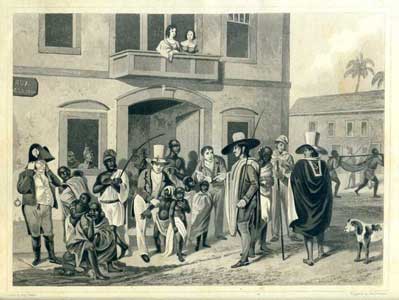
|
|
Graham's Journal
is one of the few direct accounts of the independence movement
in Brazil. She lived in Brazil at a key historical moment
and met major political figures of the day.
Maria Graham was a
Rear Admiral's daughter, married to a sea captain. The Grahams
met on a long voyage to India, traveled to Ceylon together
and then to Chile (1821), when her husband died en route.
Maria stayed for a year in Chile, sailed to Brazil in 1823,
and then back to England in 1826-27. She then remarried
and continued to travel in Europe and to write books.
|
Frances
Calderon de la Barca (1804-1882)
This is the earliest
direct account of Mexico written by a woman. Frances Erskine
Inglis, born in Scotand and raised in Massachusetts, married
the Spanish Minister to the United States, Don Angelo Calderon
de la Barca, in 1838. She traveled with him to Mexico in
1839, when he was appointed Spanish ambassador there. Her
travel book gives a lively and intelligent account of nineteenth-century
Mexican life, culture and politics (including two revolutions).
|
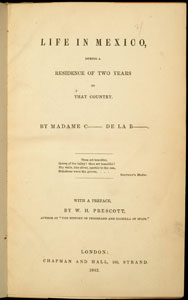
Life
in Mexico, during a Residence of Two Years in that Country.
London: Chapman and Hall, 1843. |
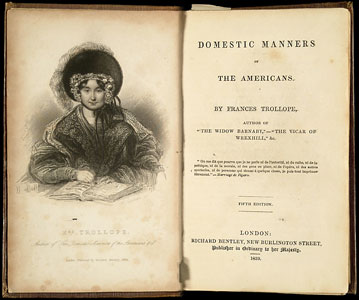
Frances Trollope.
Domestic Manners of the Americans. London: Richard
Bentley, 1839. |
Frances Trollope
(1780-1863)
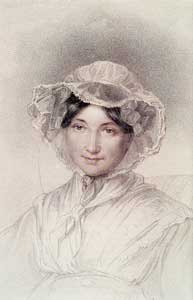
|
| Mrs. Trollope’s
first and best-known book, first published in 1832. Her scathing
criticism of their “domestic manners” scandalized
Americans. She concludes, “…of the population
generally as seen in town and country, among the rich and
poor, in the slave states and in the free states … I
do not like them. I do not like their principles, I do not
like their manners, and I do not like their opinions.”
Domestic Manners was an instant best seller in New
York and London. |
Autograph
letter to Frances Trollope from Frances Wright. September
17, 1827.
|
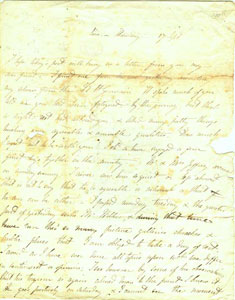
[click
on image to enlarge] |
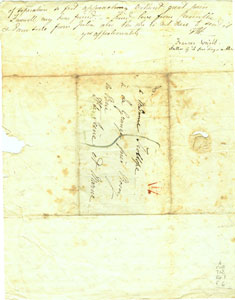
[click
on image to enlarge]
|
|
Frances
Trollope actually came to America intending to assist her
friend Frances Wright at the utopian colony Wright had founded
in the wilds of Tennessee, called Nashoba. The two women
idealistically planned to run an experimental school for
the education of freed American slaves. Trollope found the
place a desolate mess and “convinced that every idea
I had formed of the place was untrue,” fled. |
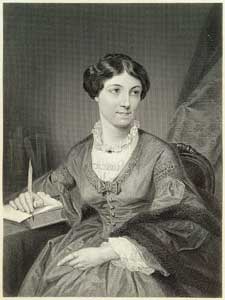 |
Harriet Martineau
(1802-1876)
Martineau was a feminist, early sociologist and prolific author.
She wrote two travel books about the United States after a
trip there in the 1830s - Society in America and
Retrospect of Western Travel.
Martineau
is quite upbeat and complimentary about the United States
in Retrospect, probably in reaction to Trollope’s
slap in the face to Americans.
|
| Harriet
Martineau. Retrospect of Western Travel. London:
Harper and Brothers, 1838. |
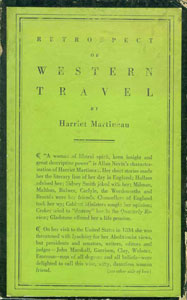 |
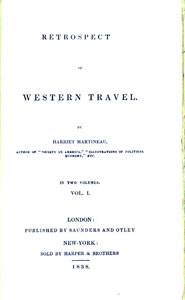 |
Ida Pfeiffer (1797-1858)
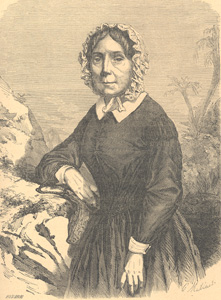
Meine zweite
Weltreise. Vienna: C. Gerold's Son,
1856. |
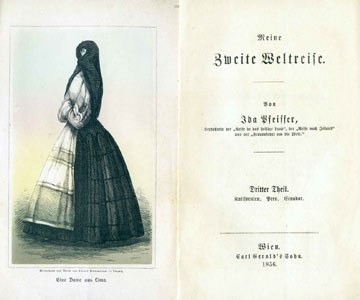
Part Three of a German edition of
Pfeiffer’s Second Journey Round the World,
containing her travels to California and South America. |
| AMERICAN LADY TRAVELERS
The first American women’s accounts of travel abroad
did not appear until the 1830s. The best-known American
women travelers include: Nellie Bly, Margaret Fuller, Sophia
Hawthorne, Nancy Prince, Harriet Beecher Stowe and Fanny
Bullock Workman. |
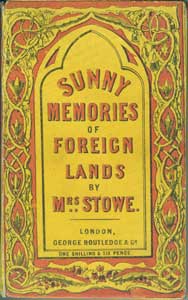
Harriet Beecher
Stowe. Sunny Memories of Foreign Lands. London:
Sampson Low, Son, & Co., 1854. |
After the great
success of Uncle Tom’s Cabin, both in
America and abroad, Beecher Stowe toured Europe three
times between 1853 and 1859. This book describes her
experiences there and the literary friendships she formed
with George Eliot and Elizabeth Barrett Browning, among
others. |
Mrs. Workman
being pulled from a crevasse
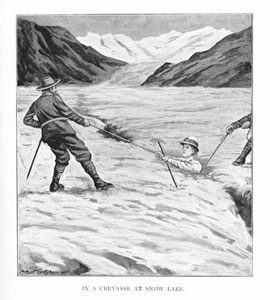
Fanny Bullock
Workman. In the Ice World of Himalaya. New
York: Cassell & Co., 1900.
Bullock Workman is one of the
great American lady travelers and a dedicated supporter
of women’s rights. She was an award-winning
mountaineer and a surveyor who, along with her husband,
made eight expeditions to the Karakorams.
|
finis. |
wilder
shores exhibit home |
europe
| russia
| turkey
| the
middle east | india
and the far east | africa
| the
americas | credits
©
2007 by the Regents of the University of California. All rights
reserved. |
|
Wilder
Shores is organized geographically, loosely following the structure
of Barbara Hodgson’s book No Place for a Lady: Tales of Adventurous
Women Travelers. (Berkeley: Ten Speed Press, 2002). The exhibit features
books and manuscripts, both by and about, women who traveled to these
regions:
|

